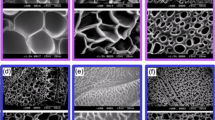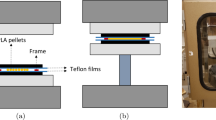Abstract
The mechanical properties of dry and wet polymeric films prepared from various aqueous polymeric dispersions were evaluated by a puncture test. They were studied with respect to type of polymer dispersion [cellulosic: Aquacoat and Surelease; acrylic: Eudragit NE, L, RS, and RL 30 D], plasticizer type (water-soluble or water-insoluble), drying or curing conditions, method of film preparation (pseudolatex- vs solvent casting) and ratio of Eudragit RS/RL 30 D in mixed Eudragit RS/RL films. Dry and wet mechanical strengths of the polymeric films depended primarily on the types of the colloidal polymer dispersion and the plasticizer. Films prepared from ethylcellulose dispersions resulted in very weak and brittle films when compared to the acrylic films. Pseudolatex-cast ethylcellulose films showed lower puncture strength and elongation values when compared to those of the solvent-cast films. Curing of the pseudolatex-cast ethylcellulose films had minimal effects on their mechanical properties. Eudragit L 30D, an enteric polymer dispersion, resulted in brittle films in the dry state, but in very flexible films in the wet state because of the plasticization effect of water. Wet Eudragit RS 30 D polymer films plasticized with water-insoluble plasticizers were significantly more flexible than the corresponding wet films plasticized with water-soluble plasticizers. The water-soluble plasticizers leached from the films during exposure to the aqueous medium, while the water-insoluble plasticizers were almost completely retained within the wet films. The low permeability of a water-soluble drug, chlorpheniramine maleate, and the weak mechanical properties of Aquacoat films could suggest osmotic driven/rupturing effects as the release mechanisms from Aquacoat-coated dosage forms.
Similar content being viewed by others
REFERENCES
K. Lehmann. The application and processing of acrylic coatings in form of aqueous dispersions compared with organic solutions. Acta Pharm. Fenn. 91:225–238 (1982).
J. W. McGinity. Applications and physical-chemical properties of aqueous polymeric coatings for drug delivery systems. Proceedings of Pre-World Congress Particle Technology, Gifu, Japan, September 17–18, 1990.
S. C. Porter. Aqueous polymeric dispersions for film coating of pharmaceutical solid-dosage forms. In M. K. Sharma and F. J. Micale (eds.), Surface Phenomena and Fine Particles in Water-Based Coatings and Printing Technology, Plenum Press, New York, 1991, pp. 71–94.
J. Spitael and R. Kinget. Preparation and evaluation of free films: Influence of the method of preparation and of solvent composition upon the macroscopic and microscopic properties of the films. J. Pharm. Belg. 32:569–577 (1977).
C. A. Entwistle and R. C. Rowe. Plasticization of cellulose ethers used in the film coating of tablets. J. Pharm. Pharmacol. 31:269–272 (1979).
A. O. Okhamafe and P. York. Analysis of the permeation and mechanical characteristics of some aqueous-based film coating systems. J. Pharm. Pharmacol. 35:409–415 (1983).
C. Bindschaedler, R. Gurny, and E. Doelker. Mechanically strong films produced from cellulose acetate latexes. J. Pharm. Pharmacol. 39:335–338 (1987).
R. Bodmeier and O. Paeratakul. Dry and wet strengths of polymeric films prepared from an aqueous colloidal polymer dispersion, Eudragit RS 30 D. Int. J. Pharm., 96:129–138 (1993).
M. C. Bourne. Theory and application of the puncture test in food texture measurement. In P. Sherman (ed.), Food Texture and Rheology, Academic Press, New York, 1979, pp. 95–142.
G. W. Radebaugh, J. L. Murtha, T. N. Julian, and J. N. Bondi. Methods for evaluating the puncture and shear properties of pharmaceutical polymeric films. Int. J. Pharm. 45:39–46 (1988).
T. R. Steger. Toughness evaluation with small quantities of material. National Technical Conference on the Society of Plastics Engineers, Detroit, November 6–8, 1979.
R. Bodmeier and O. Paeratakul. Determination of plasticizers commonly used in pharmaceutical dosage forms by high performance liquid chromatography. J. Liq. Chromatogr. 14:365–375 (1991).
K. Lehmann. Chemistry and application properties of polymethacrylate coating systems. In J. W. McGinity (ed.), Aqueous Polymeric Coatings for Pharmaceutical Dosage Forms, Dekker, New York, 1989, pp. 153–245.
R. Bodmeier and O. Paeratakul. Process and formulation variables affecting the drug release from chlorpheniramine maleateloaded beads coated with commercial and self-prepared aqueous ethylcellulose pseudolatexes. Int. J. Pharm. 70:59–68 (1991).
R. D. Deanin. Plasticizers. In R. B. Seymour (ed.), Additives for Plastics, Vol. 1, Academic Press, New York, 1978, pp. 203–217.
J. Stepek and H. Daoust. Additives for Plastics, Polymers/Properties and Applications, Springer-Verlag, New York, 1983, pp. 7–33.
J. K. Sears and J. R. Darby. The Technology of Plasticizers, Wiley, New York, 1982, pp. 35–77.
R. Bodmeier and O. Paeratakul. Propranolol HCl release from acrylic films prepared from aqueous latexes. Int. J. Pharm. 59:197–203 (1990).
S. S. Jambhekar, P. J. Green, and Y. Rojanasakul. Influence of formulation and other factors on the release of chlorpheniramine maleate from polymer coated beads. Drug Đev. Ind. Pharm. 13:2789–2810 (1987).
A. G. Ozturk, S. S. Ozturk, B. O. Palsson, T. A. Wheatley, and J. B. Dressman. Mechanism of release from pellets coated with an ethylcellulose-based film. J. Controlled Release 14:203–213 (1990).
U. Iyer, W.-H. Hong, N. Das, and I. Ghebre-Sellassie. Comparative evaluation of three organic solvent and dispersion-based ethylcellulose coating formulations. Pharm. Technol. 14:68–86 (1990).
G. Zhang, J. B. Schwartz, and R. L. Schnaare. Bead coating. I. Change in release kinetics (and mechanism) due to coating levels. Pharm. Res. 8:331–335 (1991).
I. Husson, B. Leclerc, G. Spenlehauer, M. Veillard, and G. Couarraze. Modelling of drug release from pellets coated with an insoluble polymeric membrane. J. Controlled Release 17:163–174 (1991).
O. Paeratakul. Ph.D. dissertation, Pharmaceutical applications of aqueous colloidal polymer dispersions College of Pharmacy, The University of Texas at Austin, May 1993.
Author information
Authors and Affiliations
Rights and permissions
About this article
Cite this article
Bodmeier, R., Paeratakul, O. Mechanical Properties of Dry and Wet Cellulosic and Acrylic Films Prepared from Aqueous Colloidal Polymer Dispersions Used in the Coating of Solid Dosage Forms. Pharm Res 11, 882–888 (1994). https://doi.org/10.1023/A:1018942127524
Issue Date:
DOI: https://doi.org/10.1023/A:1018942127524




